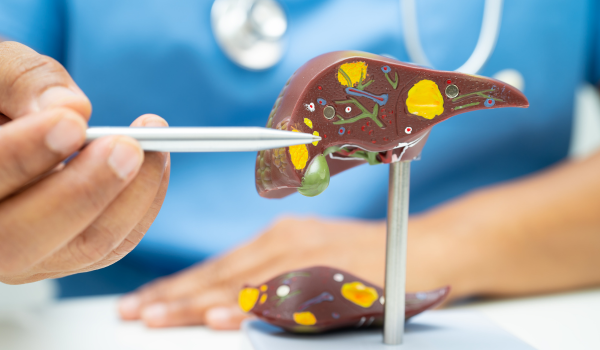Cirrhosis is a condition where scarring of the liver leads to permanent damage. Healthy liver tissue is replaced by scar tissue, preventing the liver from functioning properly. This can cause symptoms such as nausea, fatigue, itchiness, pain, and weakness.
In the early stages, you may not notice symptoms. They often appear once significant liver damage has occurred. In some cases, cirrhosis progresses quickly, leading to internal bleeding, swelling, fluid build-up in the abdomen, and yellowing of the skin and eyes.
Common Symptoms
Cirrhosis symptoms are often mild or absent in the early stages. They may appear when excessive scar tissue replaces healthy tissue. Common symptoms include:
-
fatigue
-
itchy skin
-
mild pain in the upper right side of the abdomen
-
muscle weakness and cramps
-
nausea
-
weight loss
Advanced Symptoms
As cirrhosis progresses, more severe symptoms can develop, indicating worsening liver function:
-
ascites – fluid build-up in the abdomen causing swelling
-
edema – fluid retention causing swelling in the legs, feet, or ankles
-
hepatic encephalopathy – toxin build-up in the brain due to reduced liver filtering
-
internal bleeding – often from enlarged veins (varices) in the esophagus, intestines, or stomach
-
jaundice – yellowing of the skin and eyes, often preceded by dark urine and pale stools
Symptoms by Stage
Cirrhosis symptoms can be grouped into two stages: compensated and decompensated. Early detection can sometimes reverse progression.
-
compensated – no obvious symptoms yet; liver scarring is present but not severe enough to cause noticeable issues; average survival time is around 12 years after onset
-
decompensated – presence of one or more complications like bleeding, ascites, jaundice, or hepatic encephalopathy; can progress quickly to liver failure; average survival time is about 2–4 years, though early treatment may improve outcomes
Symptoms in Children
Cirrhosis in children and adolescents usually stems from chronic liver conditions. Symptoms are similar to those in adults.
Early signs may include:
-
unexpected weight loss
-
fatigue
-
muscle weakness
-
nausea or vomiting
Severe symptoms can include:
-
ascites
-
inflammation of the abdominal lining
-
internal bleeding
When to Contact a Healthcare Provider
Cirrhosis symptoms often appear after significant, irreversible liver damage. Seek medical advice if you experience:
-
black or bloody stools
-
confusion
-
persistent or severe abdominal pain
-
recurring fever
-
signs of jaundice
-
swollen legs or ankles
-
fluid build-up in the abdomen
Your healthcare provider may order blood tests, imaging, or a liver biopsy to confirm cirrhosis. You may also be referred to a hepatologist, a specialist in liver conditions.
A Quick Review
Cirrhosis occurs when scar tissue replaces healthy liver tissue, impairing liver function. Symptoms often appear late, starting with fatigue, nausea, abdominal discomfort, and muscle weakness, and can progress to severe complications.
Prompt evaluation by a healthcare provider is essential to prevent further liver damage and improve long-term health outcomes.



